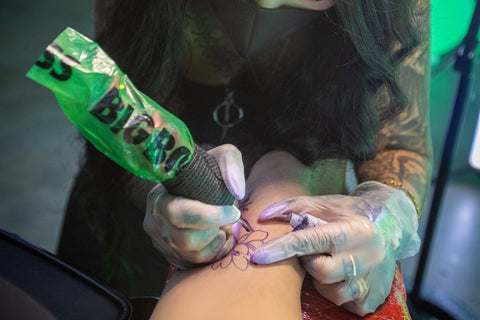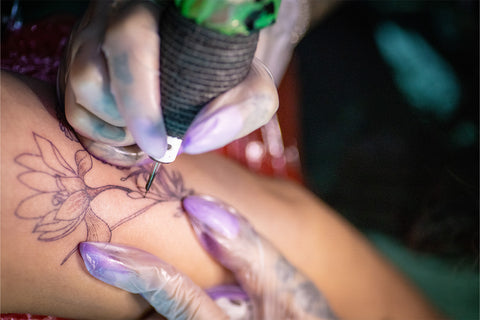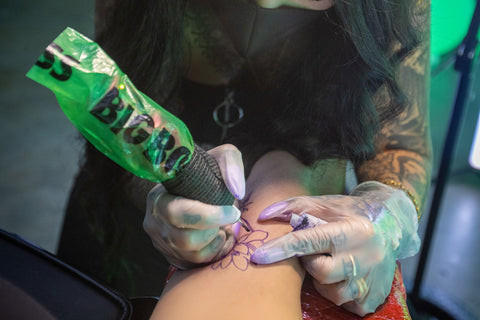How Do They Do Tattoos? The art of tattooing involves intricate techniques, skilled artists, and meticulous procedures to create stunning body art. At tattooat.com, we’re here to guide you through every step of this fascinating process, ensuring you understand how tattoos are applied and what makes them permanent. Learn about the application methods, the importance of sanitation, and the artist’s expertise, all aimed at making your tattoo experience exceptional.
1. Understanding the Tattooing Process: A Step-by-Step Guide
The tattooing process is a fascinating blend of art and science. It involves several crucial steps, each requiring precision and expertise from the tattoo artist. So, how do they do tattoos? Let’s explore each stage in detail.
- Step 1: Consultation and Design Selection: The journey begins with a consultation where you discuss your ideas with the artist. This stage is crucial for finalizing the design, size, and placement of your tattoo.
- Step 2: Preparation: The artist prepares the skin by cleaning and shaving the area. A stencil of the design is then applied to ensure accurate placement.
- Step 3: Tattooing: Using a tattoo machine, the artist inserts ink into the dermis layer of the skin. This is done by repeatedly piercing the skin with needles that deposit the ink.
- Step 4: Aftercare: Once the tattoo is complete, the artist cleans and bandages the area, providing detailed aftercare instructions to ensure proper healing.
 Tattoo artist carefully applying a stencil to a client's arm before starting the tattoo
Tattoo artist carefully applying a stencil to a client's arm before starting the tattoo
2. The Tattoo Artist’s Toolkit: Essential Equipment and Their Uses
Tattoo artists rely on a range of specialized tools to create their art. Understanding these tools can provide insight into how they do tattoos and achieve such detailed results.
| Tool | Use |
|---|---|
| Tattoo Machine | Inserts ink into the skin using oscillating needles. |
| Needles | Various sizes and configurations to create different effects, from outlining to shading. |
| Inks | Pigmented liquids specifically designed for tattooing, available in a wide array of colors. |
| Stencil Paper & Solution | Transfers the tattoo design onto the skin for accurate tracing. |
| Autoclave | Sterilizes equipment to prevent infections. |
| Medical Supplies | Includes gloves, antiseptic solutions, bandages, and ointments for maintaining hygiene and promoting healing. |
| Power Supply | Regulates the power to the tattoo machine. |
3. Tattoo Machines: Rotary vs. Coil – Which One is Better?
Tattoo machines are the heart of the tattooing process. There are two main types: rotary and coil machines. Each has its unique characteristics and advantages.
- Coil Machines: These traditional machines use electromagnetic coils to move the needles. They are known for their power and distinct buzzing sound.
- Rotary Machines: These machines use a motor to move the needles in a smooth, circular motion. They are generally quieter and offer more consistent performance.
The choice between rotary and coil machines often comes down to personal preference and the specific needs of the tattoo. According to Inked Magazine, many artists prefer rotary machines for their versatility and ease of use, while others stick with coil machines for their traditional feel and power.
4. The Role of Tattoo Ink: Composition, Safety, and Color Variations
Tattoo ink is more than just color; it’s a complex mixture that must be safe and long-lasting.
- Composition: Tattoo inks consist of pigments and a carrier solution. Pigments provide the color, while the carrier solution keeps the pigments evenly distributed and helps deliver them into the skin.
- Safety: High-quality inks are made from non-toxic materials and are rigorously tested to ensure they meet safety standards. It’s crucial to choose reputable brands to avoid allergic reactions or infections.
- Color Variations: Tattoo inks come in a vast array of colors, allowing artists to create intricate and vibrant designs. The choice of colors can significantly impact the overall look and feel of the tattoo.
5. Sterile Environment: Why Sanitation is Paramount in Tattooing
Maintaining a sterile environment is critical in tattooing to prevent infections and ensure client safety. Tattoo artists follow strict protocols to minimize the risk of contamination.
- Autoclaving: All reusable equipment, such as tubes and grips, must be sterilized in an autoclave, a device that uses high-pressure steam to kill bacteria and viruses.
- Single-Use Needles: Needles are always single-use and come in sterile packaging. Once used, they are disposed of in a sharps container.
- Surface Disinfection: All surfaces in the work area are disinfected before and after each client to prevent cross-contamination.
- Personal Protective Equipment (PPE): Artists wear gloves, masks, and aprons to protect themselves and their clients from potential pathogens.
According to a study by Portland State University’s Art Department in July 2023, proper sanitation practices significantly reduce the risk of tattoo-related infections.
6. Skin Preparation: Ensuring a Clean Canvas for Tattooing
Proper skin preparation is essential for a successful tattoo. It involves several steps to ensure the skin is clean and ready to receive the ink.
- Cleaning: The area to be tattooed is thoroughly cleaned with an antiseptic solution to remove dirt, oil, and bacteria.
- Shaving: Hair in the area is shaved to provide a smooth surface for the stencil and tattooing process.
- Stencil Application: A stencil of the design is applied to the skin using a transfer solution. This acts as a guide for the artist during the tattooing process.
7. Stencil Application: Transferring the Design with Precision
Stencil application is a crucial step in ensuring the tattoo design is accurately transferred to the skin.
- Creating the Stencil: The design is first printed or drawn onto stencil paper.
- Transferring the Design: The stencil paper is then placed on the skin, and a transfer solution is applied to transfer the design.
- Checking the Placement: The artist carefully checks the placement of the stencil to ensure it aligns with the client’s preferences and the natural contours of the body.
8. Tattooing Techniques: Outlining, Shading, and Color Packing Explained
Tattoo artists use various techniques to create different effects in their work. Understanding these techniques can help you appreciate the skill and artistry involved in tattooing.
- Outlining: This technique involves creating the basic structure of the tattoo using fine lines. It requires precision and a steady hand.
- Shading: Shading adds depth and dimension to the tattoo. Artists use different needle groupings and techniques to create gradients and shadows.
- Color Packing: Color packing involves filling in areas of the tattoo with solid colors. This requires careful layering of ink to achieve even and vibrant results.
9. Pain Management: How Artists Minimize Discomfort During Tattooing
While tattooing can be uncomfortable, artists use various techniques to minimize pain and discomfort.
- Numbing Creams: Topical numbing creams can be applied to the skin before tattooing to reduce sensation.
- Breaks: Artists often take breaks during long sessions to allow the client to rest and recover.
- Communication: Open communication between the artist and client is essential. The artist can adjust their technique based on the client’s feedback.
- Proper Equipment: Using well-maintained and high-quality equipment can also help minimize discomfort.
 Close-up of a tattoo artist working on a client's arm, showcasing the precision and skill involved
Close-up of a tattoo artist working on a client's arm, showcasing the precision and skill involved
10. The Healing Process: What to Expect and How to Care for Your New Tattoo
The healing process is a critical part of getting a tattoo. Proper aftercare is essential to prevent infections and ensure the tattoo heals correctly.
- Initial Days: The tattoo will be tender and may appear red and swollen. It’s important to keep the area clean and moisturized.
- Peeling and Itching: As the tattoo heals, it will start to peel and itch. Avoid scratching or picking at the skin.
- Long-Term Care: Once the tattoo is fully healed, continue to moisturize the area and protect it from the sun to keep it looking vibrant.
- Potential Issues: Be aware of signs of infection, such as excessive redness, swelling, or pus. If you experience any of these symptoms, seek medical attention immediately.
11. Aftercare Products: Choosing the Right Solutions for Tattoo Healing
Selecting the right aftercare products is crucial for proper tattoo healing.
| Product | Benefits | Ingredients to Look For |
|---|---|---|
| Tattoo Balm | Moisturizes and protects the tattoo, promoting faster healing. | Shea butter, coconut oil, vitamin E |
| Antibacterial Soap | Cleanses the tattoo gently, preventing infections. | Mild, fragrance-free formulas |
| Sunscreen | Protects the tattoo from UV damage, preventing fading. | Broad-spectrum, high SPF |
| Healing Ointment | Soothes irritated skin and reduces inflammation. | Aloe vera, calendula |
12. Common Mistakes to Avoid During Tattoo Aftercare
Avoiding common mistakes during aftercare can significantly improve the healing process.
- Over-Moisturizing: Applying too much lotion can trap moisture and lead to bacterial growth.
- Scratching: Scratching can damage the healing skin and increase the risk of infection.
- Sun Exposure: Direct sun exposure can cause the tattoo to fade and damage the skin.
- Swimming: Swimming in pools or oceans can expose the tattoo to harmful bacteria and chemicals.
- Tight Clothing: Wearing tight clothing can irritate the tattoo and slow down the healing process.
13. Touch-Ups: When and Why Are They Necessary?
Touch-ups are sometimes necessary to correct imperfections or refresh the tattoo’s appearance.
- Fading: Over time, tattoos can fade due to sun exposure or natural aging.
- Inconsistent Ink: Sometimes, ink may not be evenly distributed, resulting in patchy areas.
- Minor Imperfections: Small imperfections can occur during the healing process.
- Significant Changes: Weight gain or loss can stretch or distort the tattoo, requiring a touch-up.
14. Tattoo Styles: Exploring Different Artistic Approaches
Tattooing encompasses a wide range of styles, each with its unique characteristics and techniques.
- Traditional: Bold outlines and vibrant colors, often featuring classic motifs.
- Realism: Highly detailed and lifelike images, often based on photographs.
- Watercolor: Soft, flowing designs that mimic the look of watercolor paintings.
- Geometric: Intricate patterns and shapes, often using precise lines and symmetry.
- Tribal: Bold, black designs inspired by indigenous cultures.
- Blackwork: Predominantly black ink, often used for bold and graphic designs.
15. Finding the Right Tattoo Artist: Factors to Consider
Choosing the right tattoo artist is crucial for a successful and satisfying experience.
- Portfolio: Review the artist’s portfolio to assess their style and skill level.
- Specialization: Look for an artist who specializes in the style you’re interested in.
- Hygiene: Ensure the studio is clean and follows strict sanitation protocols.
- Consultation: Schedule a consultation to discuss your ideas and get a feel for the artist’s personality and approach.
- Reviews: Read reviews from previous clients to get an idea of their experience with the artist.
16. Tattoo Placement: Considerations for Design and Longevity
The placement of your tattoo can significantly impact its appearance and longevity.
- Visibility: Consider how visible you want the tattoo to be in different situations.
- Pain Level: Some areas of the body are more sensitive than others.
- Skin Elasticity: Areas with high skin elasticity, such as the stomach, may be prone to stretching and distortion over time.
- Sun Exposure: Areas that are frequently exposed to the sun may experience faster fading.
- Size and Shape: The size and shape of the tattoo should be appropriate for the chosen location.
17. Tattoo Trends: What’s Popular in the Tattoo World Today?
Keeping up with current tattoo trends can provide inspiration for your own designs.
| Trend | Description | Common Themes |
|---|---|---|
| Fine Line Tattoos | Delicate and intricate designs using very thin lines. | Floral patterns, geometric shapes, minimalist designs |
| Minimalist Tattoos | Simple and understated designs with clean lines and minimal detail. | Small symbols, single words, abstract shapes |
| Botanical Tattoos | Designs featuring plants, flowers, and leaves. | Realistic depictions, stylized illustrations, blackwork |
| Geometric Tattoos | Intricate patterns and shapes using precise lines and symmetry. | Mandalas, sacred geometry, abstract compositions |
| Illustrative Tattoos | Detailed and artistic designs that resemble illustrations or drawings. | Animals, portraits, landscapes |
18. The Cultural Significance of Tattoos Throughout History
Tattoos have been used for centuries as a form of self-expression, cultural identity, and spiritual practice.
- Ancient Cultures: Tattoos have been found on mummies dating back thousands of years.
- Tribal Societies: Many indigenous cultures use tattoos to mark important life events, such as initiation or marriage.
- Modern Society: Today, tattoos are a popular form of self-expression and artistic expression.
19. Addressing Tattoo Regret: Options for Removal and Cover-Ups
If you regret getting a tattoo, there are options for removal or cover-up.
- Laser Tattoo Removal: This involves using lasers to break down the ink particles in the skin.
- Surgical Excision: This involves cutting out the tattooed skin and stitching the remaining skin together.
- Cover-Up Tattoos: This involves covering the unwanted tattoo with a new design.
20. The Future of Tattooing: Innovations and Emerging Techniques
The world of tattooing is constantly evolving, with new techniques and technologies emerging all the time.
- 3D Tattoos: These tattoos use shading and perspective to create a three-dimensional effect.
- UV Tattoos: These tattoos are only visible under ultraviolet light.
- Bioprinting: This technology uses a 3D printer to deposit ink into the skin with extreme precision.
FAQ: Your Questions About How Tattoos Are Done Answered
Still curious about the ins and outs of tattooing? Here are some frequently asked questions.
- How deep does the needle go when tattooing? The needle penetrates just a few millimeters into the dermis layer of the skin.
- How long does a tattoo take to heal? It typically takes 2-4 weeks for a tattoo to heal completely.
- Can I get a tattoo if I have sensitive skin? Yes, but it’s important to choose an experienced artist and use hypoallergenic inks.
- What should I wear to my tattoo appointment? Wear loose, comfortable clothing that allows easy access to the area being tattooed.
- Can I drink alcohol before getting a tattoo? No, alcohol can thin the blood and increase bleeding during the tattooing process.
- How much does a tattoo cost? The cost of a tattoo varies depending on the size, complexity, and location of the tattoo, as well as the artist’s experience and reputation.
- Is it safe to get a tattoo while pregnant? It’s generally not recommended to get a tattoo while pregnant due to the risk of infection.
- Can I donate blood after getting a tattoo? You typically need to wait several months after getting a tattoo before you can donate blood.
- What are the long-term effects of tattooing? Tattoos are generally safe, but some people may experience allergic reactions or skin infections.
- How do I choose a tattoo design? Consider your personal interests, style, and the meaning you want to convey with your tattoo.
Getting a tattoo is an exciting journey that combines art, skill, and personal expression. By understanding the tattooing process and following proper aftercare, you can ensure a beautiful and long-lasting result.
Ready to start your tattoo journey? Explore a vast array of tattoo designs, find talented artists, and learn more about the world of tattooing at tattooat.com. Discover the perfect design, connect with a skilled artist, and gain the knowledge you need to make your tattoo dreams a reality. Visit tattooat.com today and let us help you create a masterpiece that you’ll cherish for a lifetime.
For more information, you can visit our studio at 1825 SW Broadway, Portland, OR 97201, United States or call us at +1 (503) 725-3000. You can also visit our website at tattooat.com for inspiration and to book your appointment.
